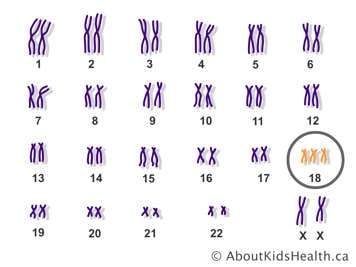What is a trisomy?
The term trisomy (say: TRY-so-mee) means that there are three chromosomes, rather than the usual pair of chromosomes. For example, a baby with Down syndrome usually has three copies of chromosome 21, rather than the usual pair. The condition is thus called "trisomy 21."
What is trisomy 18?
Trisomy 18 is a rare chromosome abnormality that affects approximately one in every 6,000 to 8,000 live births. These children have developmental delay, as well as birth defects and health problems involving nearly every organ system in the body.
Trisomy 18 is also called Edwards syndrome, after the physician who first described the disorder.

Signs and symptoms of trisomy 18
Babies with trisomy 18 have low birth weight, have a weak cry and startle to sound. They have problems feeding and fail to thrive. They have a small head size, with a prominent back of the head (occiput). Their ears are usually low-set and the openings of their eyes, their nose and their mouth are small. Their sternum (breastbone) is typically short. Almost all babies with trisomy 18 have heart defects. They have clenched fists from before birth and extending the fingers fully is difficult. Their elbows and knee joints are in a bent position rather than relaxed. They typically have club feet and their feet have been described as a “rocker bottom” due to their shape. Babies with trisomy 18 may also have spina bifida, cleft lip and palate, eye problems and hearing loss. Some develop seizures in the first year of life, kidney problems and scoliosis (curvature of the spine).
Feeding difficulties, heart problems and an increased susceptibility to infection are factors which contribute to the death of children with trisomy 18.
What causes trisomy 18?
Usually each egg and sperm cell contains 23 chromosomes. At the time of fertilization, the sperm and egg unite and create a cell with 23 chromosome pairs, or 46 chromosomes. In this manner, a child receives exactly half of their genetic material from each parent.
Sometimes, an error occurs when the egg or sperm cell is forming, causing it to have an extra chromosome. When this cell contributes the extra chromosome 18 to the embryo, trisomy 18 results. The extra chromosome 18 can come from either the mother’s egg cell or the father’s sperm cell. The abnormalities seen in babies with trisomy 18 result from having this extra chromosome 18 in each of the body’s cells.
Rarely, mosaic trisomy 18 may occur when the error in cell division occurs after fertilization. These babies have some cells with an extra chromosome 18 and others with the normal number. These babies usually have milder forms of trisomy 18.
Diagnosis of trisomy 18
Babies with trisomy 18 have a unique group of characteristics and can be diagnosed by physical examination. To confirm the diagnosis, a small blood sample can be taken and the chromosomes can be analyzed to determine the presence of an extra chromosome 18.
Chromosomal abnormalities can also be diagnosed before birth by analyzing cells in the amniotic fluid obtained by amniocentesis, or from the placenta, obtained by chorionic villus sampling (CVS) or from the fetal blood obtained by cordocentesis. Screening for trisomy 18 is also available through first trimester screening (FTS), integrated prenatal screening (IPS) or by non-invasive prenatal testing (NIPT). The diagnosis of trisomy 18 can also be suggested by detailed fetal ultrasound; however, ultrasound is not 100% accurate, since not all abnormalities can be seen on ultrasound and the same abnormalities seen prenatally in trisomy 18 can also be seen in other conditions. In contrast, a chromosome analysis, whether performed on fetal/newborn blood sample, cells from the amniotic fluid or placental sample, is over 99.9% accurate.
Life expectancy of a baby with trisomy 18
Fifty per cent of babies born with trisomy 18 survive beyond their first six to nine days. About 12% of babies born with trisomy 18 survive the first year of life. It is difficult to predict the life expectancy of a baby with trisomy 18 if the baby does not have any immediate life-threatening problems. For babies that have survived their first 30 days of life, 36% were alive at one year. About 10% of children born with trisomy 18 survive until 10 years of age.
There is a small chance of having another child with trisomy 18
The risk of having a baby with trisomy 18 increases with the mother’s age. However, the average age of the mother at delivery of a baby with trisomy 18 is 32 years. In general, in each subsequent pregnancy, the chance of having another baby with trisomy 18 is no greater than 1%.
Genetic counselling is recommended
Parents of a baby with trisomy 18 are encouraged to seek genetic counselling. This can help parents to:
- understand the results of chromosomal tests in detail
- understand the chances that other babies will be affected
- understand the diagnosis options for other pregnancies